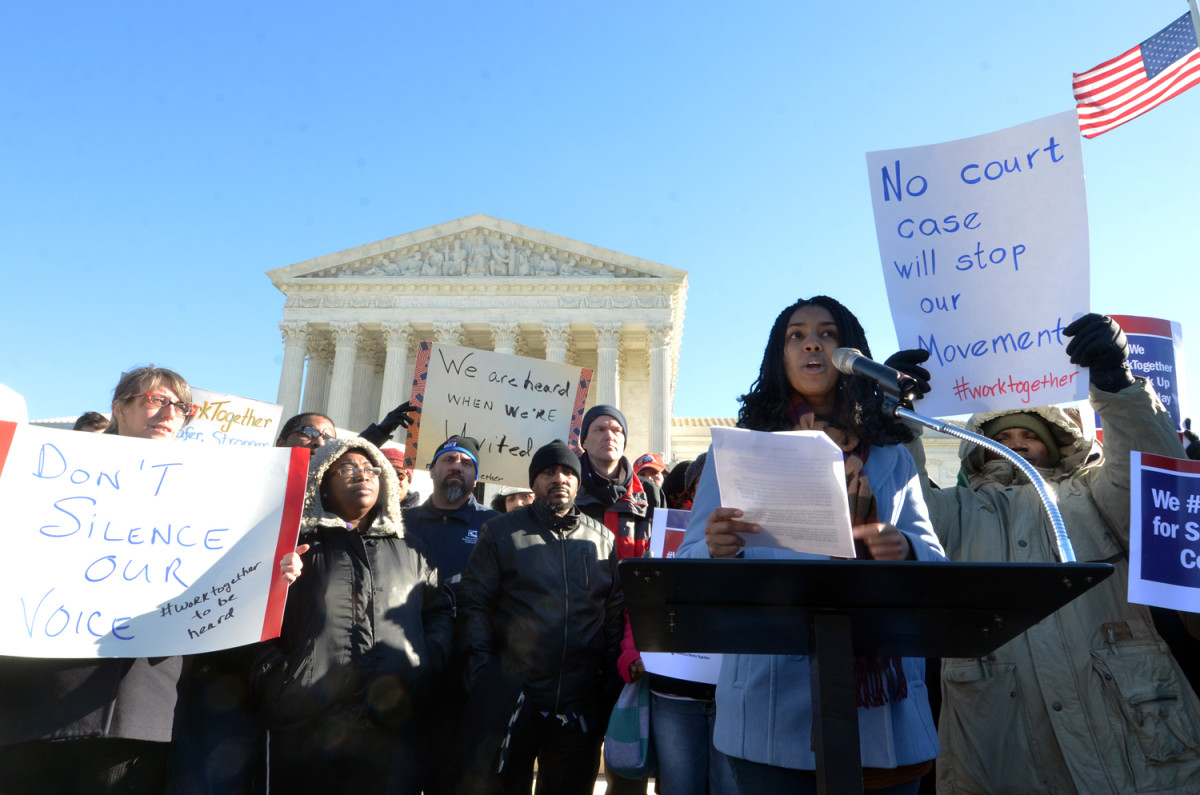When education officials in Seattle recently decided to shrink recess time at elementary schools, members of the Seattle Education Association (SEA) banded together to speak up for students. The result: Seattle elementary school students experienced a jump in their lunch and recess time from 15 minutes to a guaranteed 30 minutes a day.
The Association included the demand in a new contract, ratified last September, which also calls for educator pay increases and an examination of race and equity issues, including disparities in the suspension rates between white students and students of color. The district further agreed to a one-year moratorium on out-of-school suspensions of elementary students who commit certain nonviolent offenses, and creation of a plan to eliminate all elementary school suspensions.
All of that happened because Seattle educators were watching out for their students. And the gains are not uncommon. In other places across the nation, educators negotiate over recess and planning time. In some cases, negotiations can go beyond traditional provisions.
For example, in 2012, a member of the Dayton Education Association in Ohio filed a grievance against the principal of Belmont High School because there were no textbooks for special education students. Belmont educators spoke up. As a result, the students at Belmont—and every other special education student in Dayton Public Schools—received the textbooks they needed.
Together, educators in Seattle and Dayton prove that when basic needs like textbooks and recess minutes are on the chopping block, strong unions can ensure students’ interests take center stage at the bargaining table.
Union Strength in Jeopardy
But a pending U.S. Supreme Court case, Friedrichs v. California Teachers Association (CTA), threatens to roll back some of the positive gains for students that educators have made through student-centered bargaining.
The case challenges a public sector union’s ability to collect “fair share” or “agency” fees from employees. These fees are reduced amounts charged to workers who opt out of union membership, yet continue to receive the union representation and bargaining services that benefit all employees and which unions are required to provide.
I worry that with the wrong decision in Friedrichs, I will not be able to advocate for my students. As a union member, I know I have a voice and that through our collective bargaining process, we are ensuring quality public schools for all students.” - Maya Walker, Library Media Technician, Hayward High School, Hayward, CA.
The future of Friedrichs is unclear particularly given the vacancy on the Court left by Justice Antonin Scalia’s passing. Still, educators remain concerned. “I worry that with a wrong decision on a case like Friedrichs, I will not be able to advocate for my students,” says Maya Walker, a CTA member and library media technician at Hayward High School in Hayward, Calif. “As a union member, I know I have a voice and that through our collective bargaining process, we are ensuring quality public schools for all students.”
Montgomery County, Md., was one of 14 school districts that filed amicus, or “friend of the court,” briefs in favor of the current agency fee compromise system. The school district’s brief says educator unions have helped promote innovative solutions.
Broad Acres Elementary School is proof that union-led solutions can work. Sixteen years ago, it was the county’s highest-poverty school and on the verge of being taken over by the state. That’s when administrators and the Montgomery County Education Association formed a collaborative partnership. Within three years, Broad Acres made significant academic strides that continued to rise.
Partnership also made a difference in 2011 when teachers and administrators in Helena, Mont., joined forces to address staffing issues created by the approaching retirement of more than 50 percent of the teaching force. The district and the Helena Education Association developed an alternative compensation plan to attract more qualified teachers. The plan empowered teachers to develop and complete a career development process, perform professional service, and receive a positive evaluation. To help teachers meet these requirements, the district included professional development time within the school day, offered mentors for new teachers, and relied on a joint committee to make decisions about funding and which professional development programs to support.
Before the plan was implemented, up to 200 teachers applied for positions every year. After the plan had been in place for just one year, the district received 1,000 applications.
These transformations show that shared leadership based on the needs of students and schools works.
 Maya Walker speaks at a rally outside the U.S. Supreme Court in January.
Maya Walker speaks at a rally outside the U.S. Supreme Court in January.
What Friedrichs Claims
Rebecca Friedrichs says fair share fees violate her First Amendment rights because collective bargaining is a political activity, and paying this fee is identical to supporting lobbying efforts or campaign spending. She also believes the fee represents forced union membership.
Essentially, Friedrichs asks two questions: One, do fair share fees violate the First Amendment? And, two, does opt out—which asks educators to check a box on a form and send it to the union to opt-out of paying for lobbying or political activity—violate the First Amendment.
By law, no one is required to join a union and no one is required to pay any fees that go to politics or political candidates. Nothing in the Friedrichs case will change that.
The 1977 U.S. Supreme Court ruling in Abood v. Detroit Board of Education made clear that collective bargaining was separate from political activity. And the Court ruled that public employers could require employees – even non-members – to pay for the costs of their collective bargaining representation by the union in other words to pay their fair share fees. Each state was left to decide for itself whether to permit such fees.
According to California Attorney General Kamala D. Harris: “This case is about fairness: While no employee should be forced to pay for a union’s political speech outside the workplace, if a union represents all employees in negotiating and administering a collective bargaining agreement, then all the employees ought to share the costs of that representation. This has been the standard for the last 40 years, and there is no reason for the Supreme Court to change course now. We must protect California’s interests, fair and effective bargaining procedures, and public workers’ First Amendment rights.”
California Teachers Association President Eric Hein agreed. “The current fair share system is a good compromise and common sense solution, and that’s part of the argument we presented to the Supreme Court Justices.”
An Affront to Unions and Workers
While Friedrichs purports to be concerned with a violation of First Amendment rights, there is something more insidious at work, CTA president Heins noted during a recent interview with National Public Radio. "It's . . . about an agenda to weaken and destroy unions,” he said.
Friedrichs was dreamed up by the Center for Individual Rights (CIR), an organization formed to push the conservative agenda. CIR’s list of funders reads like a Who’s Who in the world of right wing networks and conservatism. They include Charles and David Koch, Lynde and Harry Bradley Foundation, John M. Olin Foundation, F.M. Kirby Foundation, Sarah Scaife Foundation, and the Carthage Foundation. Each of these entities has given more than $1 million in financial backing.
To push the attack forward, CIR and their attorneys rushed their case to the Supreme Court in almost unprecedented fashion, asking lower courts to rule against them so they could appeal it immediately. Although the case could impact the balance of power in our democracy and the distribution of wealth in our economy, there was no fact-finding, no record, and no trial before Friedrichs reached the highest court in the land. To wit: Friedrichs is nothing more than a broad attack on working people and their unions.
For example, West Virginia recently became the 26thstate to get right-to-work laws on the books when Republican legislators overrode the governor's veto of a right-to-work bill (which goes into effect in May). West Virginia is the fourth state to pass such a law in as many years, following Indiana, Michigan and Wisconsin.
In other states like Kentucky, passage of right-to-work legislation is possible if Republicans take control of the House after November elections. Republicans already hold a majority in the state Senate and have passed right-to-work bills.
In Missouri, Republicans have a second chance to pass right-to-work legislation this session. The state was close to enacting the policy during the last legislative session despite fierce opposition.
With the support of similar right-wing groups and special interests as those supporting the Friedrichs case, overturning Abood would call into question thousands of contracts between government agencies and public-employee unions, governing not just teachers but also law-enforcement officers, firefighters, and others.
A Right-to-Work (For Less) Nation
Potentially, Friedrichs could strip bargaining power from workers across the country.
While 23 states authorize collecting fair share fees, other states have made fair share fees illegal. The result? Lower wages and decreased benefits for working people. In states without full union rights, the average worker makes $1,500 less per year, workers are much less likely to have health insurance, and the rate of workplace deaths is 36 percent higher.
I am optimistic about the resiliency of teachers to find a way to forge ahead should we suffer a major setback. I keep on doing what’s best for kids because that’s what we do and that’s why this case is so important. If teachers lose then so do students.”
- Ron Hustvedt, Teacher, Minneapolis, Minn.
The anti-union sentiment of the case is reminiscent of other attacks against working people. One of the first such attacks was launched in 2011 by Wisconsin Gov. Scott Walker when he pushed through Act 10, a law that slashed collective bargaining rights and benefits of union members.
Labor-management agreements fell by the wayside and the average union member immediately lost about eight to 10 percent of their earnings. Educators could only negotiate salary and benefits. Improved learning and working conditions were removed from the bargaining table completely.
As a result, educators could no longer negotiate over issues like class size or the number of teachers in a room for students with specific needs. Districts started to arbitrarily give educators additional duties, requiring them to supervise extra work or stay after school.
Veteran educators—mainly those at the top of the salary schedule—were fired. Some were rehired at a lower salary. Others were handpicked to return by administrators. To further weaken unions, the state also ended fair share fee and automatic dues deduction from worker’s paychecks. Without revenue generated from automatic dues deduction, unions must make individual arrangements with members making it easier for some not to pay. Friedrichs will have similar negative repercussions, but nationwide.
“These groups want to weaken unions because they want to eliminate their last standing challenge,” says Rebecca Letter, a teacher for a Sheboygan area high school. “There’s a lot of money out there and it typically falls to big businesses, but unions are one of the last fronts that compete with big money to make sure workers are treated fairly and students and schools are funded adequately.”
After his Act 10 passed, Gov. Scott Walker made the largest budget cuts in the state’s history and attempted to close a $3.6 billion budget deficit by reducing school spending by 5.5 percent, and by cutting $792 million in school aid.
 Teacher Ron Hustvedt with his students.
Teacher Ron Hustvedt with his students.
Standing Together
At their core, all of these efforts jeopardize educators’ ability to have a voice. Ron Hustvedt, a middle school teacher in Minnesota had an experience that illustrates the importance of keeping unions strong.
While teaching in Minneapolis several years ago, Hustvedt chaired a staff development committee that was encouraged by the district to design a framework for peer coaching and Professional Learning Communities. The goal was to develop a schedule that would not interfere with a teacher’s prep time.
The group designed a format and all agreed, except the school principal, who attempted to quash the plan. Hustvedt explains that the principal viewed peer coaching as an attempt by teachers to “make more money.”
“I remember him coming into my classroom and saying, ‘You have to go along with me,’” Hustvedt recalls. To “go along” meant to stop the plan. The veteran social studies teacher had a different idea.
He contacted his local union. Days later, the pressure was off. “If I didn’t know the union was going to have my back, I would have had to go along with the principal,” he says. “It’s nice to have an organization that’s looking out for your best interest so you can serve your students well.”
Union Power!
Backed by the strength of their union, educators have the power they need to stand up for what’s best for students and the profession.
In Reading, Pa., members of the Exeter Township Education Support Professionals Association defeated a privatization plan that would have eliminated 54 bus driver jobs. Members took their concerns to the community. Soon, district residents were discussing privatization at Little League games, family picnics, business meetings, in beauty parlors, and at health clubs. The board ultimately decided against privatizing the bus fleet. This was important to residents, because the district’s bus drivers, who live in the community they serve, are connected to students. As one local parent said, “Private companies don’t know our kids.”
A strong union can also make the difference in higher education environments, where a majority of college classes are taught by adjunct or contingent faculty—non-tenure track professionals whose pay is usually low, and whose job security is scarce.
They removed educators at the top of the pay scale to fix the state’s budget, but those at the top were also the good teachers with a lot of experience— and it’s never the right choice to save money on the backs of students.”
- Rebecca Letter, Teacher, Sheboygan, Wisc.
These faculty typically share offices, and when they meet with students outside of class they aren’t compensated. But adjuncts who are members of NEA are determined to change their working conditions, which could, in turn, improve the learning conditions of college students.
At Manhattanville College in New York, adjunct faculty and tutors surprised naysayers by voting overwhelmingly for union representation. Last year, they negotiated the college’s first collective bargaining agreement—one that ensures access to funds for professional development.
Building union power is about having a vision and the courage to bring that vision into reality by stepping outside of the classroom to connect with other educators around shared interests. Union power is about feeling empowered to talk about improving the school environment for educators and students without retaliation. Most of all, it’s about being able to do these things with the protection of a union.
Recently, Deborah Hollis, a sixth-grade English Language Arts teacher at Molasky Jr. High School in Clark County, Nev., had an opportunity to see the value of her union firsthand and to experience the ways NEA members are encouraged to become vocal leaders, speaking out on behalf of their students and profession.
Earlier this year, Hollis attended an NEA leadership summit in Washington, D.C. “I kept questioning: ‘why am I here?’” she says.
She engaged with fellow educators for two days. Later, she said the gathering “made me open my mind and views. There are so many teacher leaders at my school. We just don’t know it.”
To those who are hesitant, Hollis says being a teacher leader doesn’t mean you have to leave the classroom and become an administrator. Leading the profession could be a walk across the hall to connect with other educators and share information.
 Teacher Rebecca Letter
Teacher Rebecca Letter
Closing Argument
Despite the potential for setbacks from Friedrichs and other attacks, NEA and its affiliates will remain the leading voices of the education professions, and will continue to work on behalf of students and public education. Similarly, every educator must use their voice to support colleagues and students.
“We will continue to exist, as long as educators can still form professional organizations and develop creative solutions for their students and the profession,” says Minnesota’s Hustvedt. “We’ll just need to adjust and change the way we do business.”


